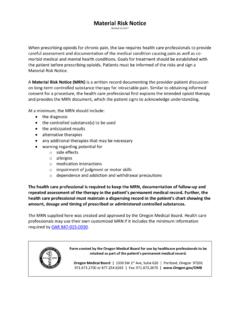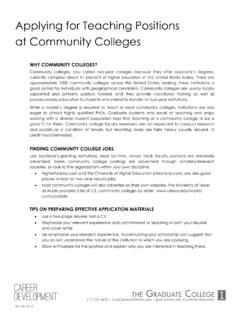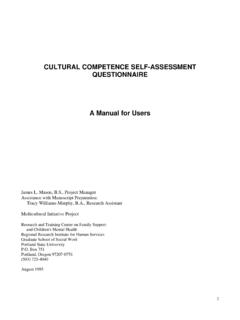Transcription of Oregon Death with Dignity Act
1 PUBLIC HEALTH DIVISIONO regon Death with Dignity Act2020 Data Summary2020 2 Acknowledgments | Oregon Death with Dignity ActAcknowledgmentsReport written by: Public Health Division, Center for Health StatisticsDate: February 26, 2021 For more information, see: : Death with Dignity Act | Executive summaryExecutive summaryThe Oregon Death with Dignity Act (DWDA) allows terminally ill Oregonians who meet specific qualifications to end their lives through voluntary self-administration of a lethal dose of medications prescribed by a physician for that purpose. The Act requires the Oregon Health Authority (OHA) to collect information about the patients and physicians who participate in the Act and to publish an annual statistical report. In 2020, 370 people were reported to have received prescriptions under the DWDA. As of January 22, 2021, 245 people had died in 2020 from ingesting the prescribed medications, including 22 who had received prescriptions in previous years.
2 Demographic characteristics of DWDA patients were similar to those of previous years: most patients were aged 65 years or older (81%) and white (97%). While cancer still accounted for most underlying illnesses (66%), patients with heart disease (11%) outnumbered those with neurological disease (8%) for the first time in 2020. OHA made no referrals to the Oregon Medical Board for failure to comply with DWDA | Oregon Death with Dignity ActThe Oregon Death with Dignity Act (DWDA) allows terminally ill Oregonians who meet specific qualifications to end their lives through voluntary self-administration of a lethal dose of medications prescribed by a physician for that purpose. The Act requires the Oregon Health Authority (OHA) to collect information about the patients and physicians who participate in the Act and to publish an annual statistical report. The DWDA outlines specific patient requirements to participate.
3 A patient must be 1) 18 years of age or older, 2) a resident of Oregon , 3) capable of making and communicating health care decisions to health care practitioners, and 4) diagnosed with a terminal illness that will lead to Death within six months. The attending and consulting physicians must determine whether a patient meets these requirements and report that fact to OHA at the time a prescription is written. When OHA identifies any issue of noncompliance with the statutory requirements, it reports the fact to the appropriate licensing presented in this summary, including the number of people for whom DWDA prescriptions were written (DWDA prescription recipients) and the resulting deaths from the ingestion of the medications (DWDA deaths), are based on required reporting forms and Death certificates received by OHA as of January 22, 2021. More information on the reporting process, required forms and annual reports is available at Introduction*As of January 22, 2021 See Table 2 for detailed informationFigure 1: DWDA prescription recipients and deaths*, by year, Oregon , 1998 2020050100150200250300350400 Prescriptions written'20'19'18'17'16'15'14'13'12'11'10 '09'08'07'06'05'04'03'02'01'00'99'98 YearNumberDWDA deaths5 Oregon Death with Dignity Act | Participation summary and trendsDuring 2020, 370 people received prescriptions for lethal doses of medications under the provisions of the Oregon DWDA, a 25% increase over the 297 reported during 2019 (Figure 1).
4 As of January 22, 2021, OHA had received reports of 245 people who died during 2020 from ingesting the medications prescribed under the DWDA, an increase from 191 in the law was passed in 1997, a total of 2,895 people have received prescriptions under the DWDA and 1,905 people (66%) have died from ingesting the medications. During 2020, the estimated rate of DWDA deaths was per 10,000 total 2 shows a summary of DWDA prescriptions written and medications ingested. Of the 370 patients for whom prescriptions were written during 2020, 223 (60%) died from ingesting the medication. An additional 67 (18%) did not take the medications and later died of other the time of reporting, ingestion status was unknown for 80 patients prescribed DWDA medications in 2020. Of these, 36 patients died but follow up information is not yet available. For the remaining 44 patients, both Death and ingestion status are not yet known (Figure 2).
5 In all, eight patients ( ) outlived their prognosis ( , lived more than six months after their prescription).Participation summary and trendsFigure 2: Summary of DWDA prescriptions written and medications ingested in 2020, as of January 22, 2021370 people had prescriptions written during 202067 did not ingest medication and later died from other causes80 ingestion status unknown36 died, ingestion status unknown44 Death and ingestion status unknown22 people with prescriptions written in previous years ingested medication during 2020223 ingested medication245 died from ingesting medication in 20201 Rate per 10,000 deaths calculated using the total number of Oregon resident deaths in 2019 (37,397), the most recent year for which final Death data are characteristics | Oregon Death with Dignity ActTable 1 shows the characteristics and end-of-life care for 2020 DWDA deaths, updated data for 2019 DWDA deaths, combined data for 1998 2018 DWDA deaths, and total DWDA deaths.
6 Of the 245 DWDA deaths during 2020, most patients were aged 65 years or older (81%) and white (97%). The median age at Death was 74 years. Forty-two percent of patients had at least a bachelor s underlying illnesses were somewhat different from those of previous years. Cancer remained the most common underlying illness, but now accounts for only two-thirds (66%) of DWDA deaths. In previous years, with a few exceptions, cancer accounted for 70% 85% of underlying illnesses. In addition, patients with heart disease (11%) outnumbered those with neurological disease (8%) for the first time in patients died at home (92%) and most were enrolled in hospice care (95%). All patients whose health insurance status was known had some form of coverage. The percent of patients with private insurance declined from 2019 (from 29% to 26%), while patients with Medicare or Medicaid insurance increased (from 70% to 74%).
7 As in previous years, the three most frequently reported end-of-life concerns were decreasing ability to participate in activities that made life enjoyable (94%), loss of autonomy (93%) and loss of Dignity (72%).Patient characteristics7 Oregon Death with Dignity Act | DWDA processA total of 142 physicians wrote 370 prescriptions during 2020 (1 31 prescriptions per physician; 79% of physicians wrote one or two prescriptions). The number of attending physicians has increased most years since 1998 and has increased at a higher rate since 2014 (Table 2). Almost half of attending and consulting physicians practiced in the portland metropolitan area (48% and 49%, respectively), while just under 30% practiced in the other northwestern counties (Table 3). Three patients were referred for psychological or psychiatric evaluation. During 2020, OHA made no referrals to the Oregon Medical Board for failure to comply with DWDA DWDA now provides an exemption to the statutory waiting periods for patients expected to live fewer than 15 days from the time of their first oral request for medication.
8 In 2020, 75 patients (20%) were given medications prescribed to DWDA patients continues to evolve (Table 1). In 2019, more than 90% of DWDA ingestions involved one of two drug combinations: DDMA, consisting of diazepam, digoxin, morphine sulfate, and amitriptyline (47% of ingestions); or DDMP, consisting of diazepam, digoxin, morphine sulfate, DWDA processFigure 3: Medication used in DWDA ingestions, 2013-202020'19'18'17'16'15'14'13 PrescriptionsSecobarbitalSecobarbitalPhe nobarbitalPhenobarbitalDDMPDDMPDDMADDMAD DMA-Ph2013200150100500201420152016201720 18201920208 Patient characteristics | Oregon Death with Dignity Actand propranolol (46% of ingestions). In 2020, most ingestions involved DDMA (87%). Only 10% of ingestions used DDMP. In late 2020, some physicians began to prescribe a new drug combination DDMA-Ph consisting of DDMA with the addition of phenobarbital (Figure 3).
9 Prescribing physicians were present at time of Death for 29 patients (12%). Fifty-five patients (22%) had other health care providers present, and volunteers were present for 42 deaths (24%). 1 Data on time from ingestion to Death are available for 138 DWDA deaths (56%) during Among those patients, time from ingestion until Death ranged from six minutes to eight hours, with a median time of 50 minutes (Table 1). Table 4 shows the duration from ingestion to Death by medication prescribed for all known cases. Median time until Death was shorter after DDMA (53 minutes) than after DDMP (85 minutes). All drug combinations have shown longer median times until Death than the barbiturates, secobarbital and pentobarbital, which are no longer readily available. There is not yet sufficient data on the new drug combination, DDMA-Ph, to estimate its Due to COVID-19 precautions, providers and volunteers attended some DWDA ingestions remotely using teleconferencing software ( , Zoom).
10 2 Includes all reports, not just those from licensed health care Death with Dignity Act | Patient characteristicsTable 1. Characteristics and end-of-life care of 1,905 DWDA patients who have died from ingesting a lethal dose of medication as of January 22, 2021, Oregon , 1998 2020202020191998 2018 Tot alCharacteristics(N=245)(N=191)(N=1,469) (N= 1,905)SexN (%)1N (%)1N (%)1N (%)1 Male 124( )114( )767( )1,0 05( )Female 121( )77( )702( 4 7. 8 )900( 4 7. 2 )Age18 34 1( )1( )9( )11( )35 44 4( )4( )28( )36( )45 54 11( )11( )85( )107( )55 64 30( )32( )277( )339( 17. 8 )6 5 74 83( )56( )443( )582( )75 84 65( )56( )397( 2 7. 0 )518( 2 7. 2 )85+ 51( )31( )230( )312( )Median years (range)74(33-99)74(33-98)72(25 -10 2)72(25 -10 2)RaceWhite 238( 9 )184( )1,411( )1,833( )African American 0( )0( )1( )1( )American Indian 0( )0( )3( )3( )Asian 3( )2( )21( )26( )Pacific Islander 0( )0( )1( )1( )Other 1( )1( )4( )6( )Two or more races1( )0( )7( )8( )Hispanic 2( )4( )16( )22( )Unknown0055 Marital statusMarried (including Registered Domestic Partner) 113(4 6.)


















